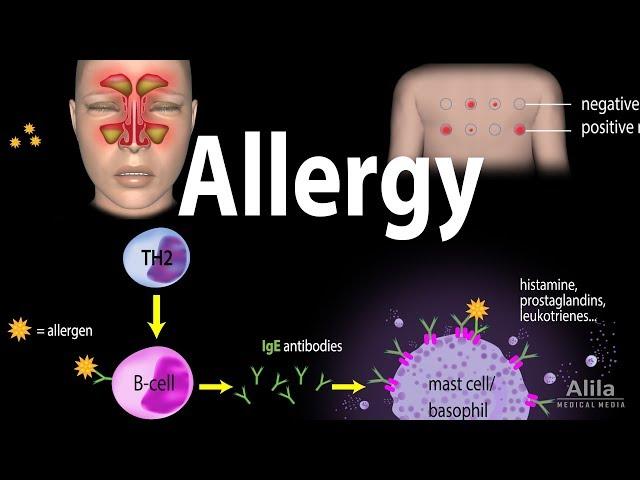
Allergy - Mechanism, Symptoms, Risk factors, Diagnosis, Treatment and Prevention, Animation
(USMLE topics) Development of allergic diseases, etiology and pathology.
Purchase a license to download a non-watermarked version of this video on AlilaMedicalMedia(dot)com
Check out our new Alila Academy - AlilaAcademy(dot)com - complete video courses with quizzes, PDFs, and downloadable images.
Voice by: Ashley Fleming
©Alila Medical Media. All rights reserved.
All images/videos by Alila Medical Media are for information purposes ONLY and are NOT intended to replace professional medical advice, diagnosis or treatment. Always seek the advice of a qualified healthcare provider with any questions you may have regarding a medical condition.
Allergy refers to abnormal reactions of the immune system to otherwise harmless substances. Normally, the immune system raises immune response to protect the body from foreign invaders, such as bacteria or viruses, but does not react to non-infectious environmental antigens. In people with allergies, however, the immune system also reacts to these substances, producing allergic reactions. Such substances, called allergens, can come from the patient’s natural environment, foods, medications, latex products, or insect bites.
Most allergies are mediated by a class of antibody called immunoglobulin E, IgE. IgE is produced when the body is first exposed to an allergen. Production of IgE is activated by a subtype of T-lymphocytes, known as type 2 helper T-cells, TH2. IgE molecules then bind to their receptors on the surface of mast cells and basophils. The first exposure is usually asymptomatic, but the body is now sensitized. Upon reexposure to the same antigen, the antigen binds to adjacent IgE molecules, bringing their receptors together, triggering a signaling cascade that induces the release of histamine and other inflammatory chemicals. These chemicals cause dilation and increased permeability of blood vessels, mucus secretion, stimulation of sensory nerves, smooth muscle spasms, and are responsible for allergic symptoms, which can range from mild to severe. Mild symptoms usually consist of watery eyes, runny nose, sneezing and a mild rash; while severe reactions may include swelling, hives, difficulty breathing due to bronchospasm, and digestive problems due to increased gastrointestinal motility. When released systemically, these chemicals can cause extensive vasodilation and smooth muscle spasms which may lead to anaphylaxis, a life-threatening condition in which blood pressure drops and airways narrow to a dangerous level.
The reactions are immediate, within minutes of contact with the allergen. There is also a late phase response, due to subsequent tissue infiltration with eosinophils and other inflammatory cells.
People who are sensitized to a specific allergen may also react to other substances that contain similar antigens. This is called cross-reactivity. For example, people who are allergic to birch pollen may also have reactions to certain fruits and vegetables such as apples or potatoes, consumption of which can cause itching and swelling of the lips and oral cavity.
Both genetic and environmental factors contribute to the development of allergic diseases.
Allergies tend to run in families. What is inherited is the susceptibility to allergic reactions, due to irregularities in the makeup of the immune system.
Early childhood exposures to bacterial and viral infections are thought to suppress TH2 cells and are therefore protective against allergic diseases. This theory, known as hygiene hypothesis, implies that living in too sterile an environment is a risk factor for allergic diseases. While still a hypothesis, it does partly explain the higher prevalence of allergies in developed countries. Other risks factors include exposure to allergens and stress.
Diagnosis is usually based on symptoms and patient’s history. Potential allergens may be identified with skin prick test or intradermal test, where small amounts of common allergens are introduced into the skin and local reactions are observed. A blood test, called allergen-specific serum IgE test, can also be performed. In this case, patient’s blood sample containing IgE is tested for binding to common allergens. If binding occurs, the person is allergic to that allergen.
Antihistamines are effective for treatment of mild allergies. Other drugs include mast cell stabilizers, corticosteroids and leukotriene modifiers. Severe reactions require immediate injection of epinephrine.
The best way to prevent allergies is to avoid the offending allergens. People with serious reactions to unavoidable allergens may benefit from immunotherapy. In immunotherapy, patients are injected weekly with gradually increasing doses of the allergen, starting with a tiny amount. This process desensitizes the immune system, reducing reactions to the allergen, but may take several years to complete.
Purchase a license to download a non-watermarked version of this video on AlilaMedicalMedia(dot)com
Check out our new Alila Academy - AlilaAcademy(dot)com - complete video courses with quizzes, PDFs, and downloadable images.
Voice by: Ashley Fleming
©Alila Medical Media. All rights reserved.
All images/videos by Alila Medical Media are for information purposes ONLY and are NOT intended to replace professional medical advice, diagnosis or treatment. Always seek the advice of a qualified healthcare provider with any questions you may have regarding a medical condition.
Allergy refers to abnormal reactions of the immune system to otherwise harmless substances. Normally, the immune system raises immune response to protect the body from foreign invaders, such as bacteria or viruses, but does not react to non-infectious environmental antigens. In people with allergies, however, the immune system also reacts to these substances, producing allergic reactions. Such substances, called allergens, can come from the patient’s natural environment, foods, medications, latex products, or insect bites.
Most allergies are mediated by a class of antibody called immunoglobulin E, IgE. IgE is produced when the body is first exposed to an allergen. Production of IgE is activated by a subtype of T-lymphocytes, known as type 2 helper T-cells, TH2. IgE molecules then bind to their receptors on the surface of mast cells and basophils. The first exposure is usually asymptomatic, but the body is now sensitized. Upon reexposure to the same antigen, the antigen binds to adjacent IgE molecules, bringing their receptors together, triggering a signaling cascade that induces the release of histamine and other inflammatory chemicals. These chemicals cause dilation and increased permeability of blood vessels, mucus secretion, stimulation of sensory nerves, smooth muscle spasms, and are responsible for allergic symptoms, which can range from mild to severe. Mild symptoms usually consist of watery eyes, runny nose, sneezing and a mild rash; while severe reactions may include swelling, hives, difficulty breathing due to bronchospasm, and digestive problems due to increased gastrointestinal motility. When released systemically, these chemicals can cause extensive vasodilation and smooth muscle spasms which may lead to anaphylaxis, a life-threatening condition in which blood pressure drops and airways narrow to a dangerous level.
The reactions are immediate, within minutes of contact with the allergen. There is also a late phase response, due to subsequent tissue infiltration with eosinophils and other inflammatory cells.
People who are sensitized to a specific allergen may also react to other substances that contain similar antigens. This is called cross-reactivity. For example, people who are allergic to birch pollen may also have reactions to certain fruits and vegetables such as apples or potatoes, consumption of which can cause itching and swelling of the lips and oral cavity.
Both genetic and environmental factors contribute to the development of allergic diseases.
Allergies tend to run in families. What is inherited is the susceptibility to allergic reactions, due to irregularities in the makeup of the immune system.
Early childhood exposures to bacterial and viral infections are thought to suppress TH2 cells and are therefore protective against allergic diseases. This theory, known as hygiene hypothesis, implies that living in too sterile an environment is a risk factor for allergic diseases. While still a hypothesis, it does partly explain the higher prevalence of allergies in developed countries. Other risks factors include exposure to allergens and stress.
Diagnosis is usually based on symptoms and patient’s history. Potential allergens may be identified with skin prick test or intradermal test, where small amounts of common allergens are introduced into the skin and local reactions are observed. A blood test, called allergen-specific serum IgE test, can also be performed. In this case, patient’s blood sample containing IgE is tested for binding to common allergens. If binding occurs, the person is allergic to that allergen.
Antihistamines are effective for treatment of mild allergies. Other drugs include mast cell stabilizers, corticosteroids and leukotriene modifiers. Severe reactions require immediate injection of epinephrine.
The best way to prevent allergies is to avoid the offending allergens. People with serious reactions to unavoidable allergens may benefit from immunotherapy. In immunotherapy, patients are injected weekly with gradually increasing doses of the allergen, starting with a tiny amount. This process desensitizes the immune system, reducing reactions to the allergen, but may take several years to complete.
Тэги:
#yt:quality=high #allergic_reactions #allergies #anaphylaxis #causes #immune_disorders #cross_reactivity #anaphylactic_shock #food #health #healthcare #histamine #type_I_hypersensitivity #immunity #immunology #inflammation #lecture #mechanism_of_action #medical #peanut #pollens #presensitization #latex #acute_response #genetics #etiology #pathology #pathophysiology #diagnostic #common_allergens #blood_test #epipen #prevention #how_immunotherapy_works #desensitization #antigen #skin_testsКомментарии:
Складское оборудование компания ООО Металлкорп
МЕТАЛЛКОРП - складское и торговое оборудование
Zombie vs Hulk Can't Sleep #shortsbeta
M.R Pet And Noni
SIDEMEN PRANK TEXT ROULETTE: VOICENOTE EDITION
MoreSidemen
FEARLESS /ANIME MIX/「AMV」4K
KoNi AMVsドリルバック
Vega 3 in 40+ GAMES ( AMD Athlon 3000G) | in 2024
Zax Game Inn
Así Puedes Crear un Negocio Exitoso desde Cero
Mariano Trejo








![[연예수첩] “조연으로 사는 법”…명품 배우들의 고백 / KBS뉴스(News) [연예수첩] “조연으로 사는 법”…명품 배우들의 고백 / KBS뉴스(News)](https://rtube.cc/img/upload/Z0FsdDJlODk4eGE.jpg)

















